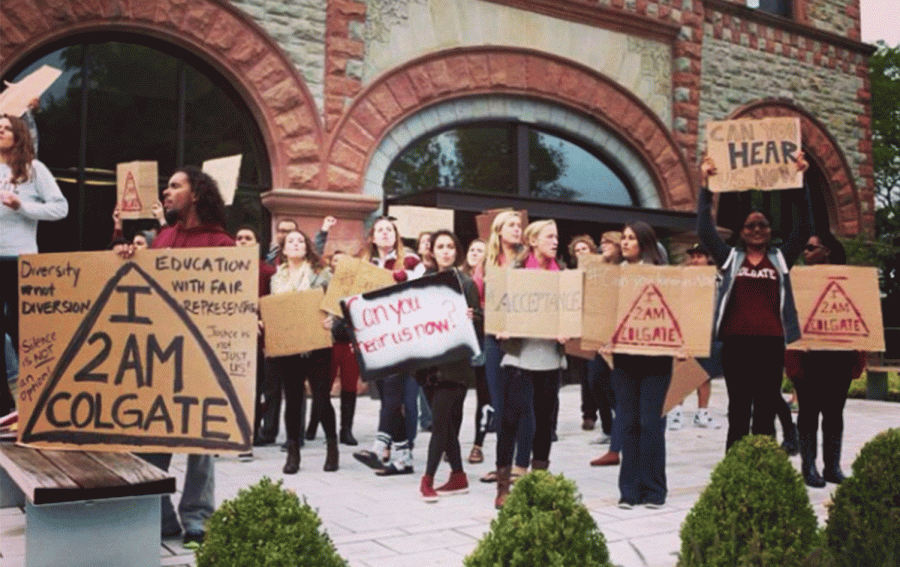Association of Critical Collegians Organizes Sit-In at Office of Admissions
Hundreds of Colgate students and faculty participated in a sit-in on September 22 to protest a negative campus climate that excludes and marginalizes various minority groups. The event was organized by Colgate’s Association of Critical Collegians (ACC), a group named after the Association of Black Collegians who organized the Colgate sit-ins of 1969, and was held in the Hurwitz Admissions Center.
Event organizers circulated a letter to students, identifying their motivations for the sit-in and an action plan of positive changes that they hope to implement in order to make Colgate a more inclusive institution. Students who sympathized with the cause were encouraged to participate. The sit-in lasted overnight, with hundreds of students sleeping inside Admissions and outside in below-30 degree weather. As of September 24, the sit-in continued to be a presence on campus as participants have committed to staying until they are satisfied with the administration’s response. According to the ACC’s Logistics Taskforce, there were approximately 300 faculty and students who signed the attendance sheet at the sit-in on Monday. At the time of publication, 519 supporters had signed the ACC’s petition onChange.org, which had a goal of 1,000 signatures.
Besides the general campus climate, specific incidents have served as the catalyst for the formation of the ACC such as insensitive Facebook status updates, an article written by a student for The Huffington Post about race relations, perceived bias in The Maroon-News’ coverage of the Ferguson rally and discriminatory YikYak posts.
The sit-in began with students marching into Admissions at 8 a.m. Students held up signs and shouted slogans such as “community not conformity” and “we want equity now” to attract the attention of other students, faculty and staff walking by. Other signs encouraged drivers to honk if they supported equity. Those involved wore Colgate gear with question marks to symbolize the uncertainty surrounding the idea of Colgate as a welcoming, inclusive institution. The participants’ choice of Colgate apparel also enforced the idea that minority groups also represent the face of Colgate. The event was publicized on social media with the hashtag “#canyouhearusnow.”
“A lot of the times when these issues are addressed [to administration or professors] they say ‘I hear you, I hear you’ … I’ve heard that line so many times, and I’m like ‘can you actually hear us? This sit-in, is it speaking loud enough for you? Is our presence speaking to you?” senior Natasha Torres, a member of the Damage Control Subcommittee, said.
Early on in the day, President Jeffrey Herbst, Vice President and Dean of the College Suzy Nelson and Provost and Dean of the Faculty Douglas Hicks met with the core members of the ACC to discuss the action steps that the protestors want accomplished.
Students then stood on the staircase one-by-one to share their own experiences at Colgate with feeling victimized by students and faculty on campus. They discussed their encounters with microaggressions and stereotypes at Colgate. While the stories shared were emotional and uniquely personal, many touched upon common themes such as social exclusivity and an unwelcome climate that distracts students from performing academically and leads students to consider transferring schools.
According to senior Kori Strother, another member of the Damage Control Subcommittee, the testimonials served an important purpose.
“Those testimonies allowed the administration to see us. We walk around campus, marginalized students, minority students, never being seen, feeling as if our identities are not important, are not validated. So it was important that they listen to us and they don’t respond. That they sit there and they just listen,” Strother said.
Herbst, Nelson and Hicks listened to these stories for many hours throughout the day. After a lunch break, the participants took a vote to determine how to proceed. The majority of participants voted in favor of continuing to address the administration, so the personal testimonies continued. After hearing these emotional accounts, the three administrators spoke to the crowd of people who had filled Admissions.
“My tears do not mean I’m weak; they do not mean I’ve lost my resolve,” Nelson said. “They only mean that I’m with you.”
Monday’s protest was designed primarily to raise awareness, but also asked for tangible actions steps. The letter asked, for instance, that Colgate cruisers be equipped with cameras and audio recording devices, and that hate speech or hate crimes receive “stronger disciplinary action.” Another request was the addition of multicultural Greek societies to offer alumni networking previously unavailable to minority groups. The event organizers requested “that all faculty, staff and administrators be engaged in sustained diversity training … in order to bring issues of diversity and intersectionality into the curriculum,” and recommended that Colgate “hire and retain more faculty of color and other minorities.” The complete list was extensive – some 25 points were made – which sought to facilitate sweeping changes to Colgate’s administrative processes and culture.
The ACC is heavily active on social media, hoping to get their message out to as many people as possible. Maintaining a presence on Photobucket, Tumblr, Twitter, Facebook, Youtube and Instagram, the ACC encouraged past and present students to voice their feelings about the protest. Many students who oppose the sit-in and its goals have reacted negatively to the movement by anonymously posting derogatory comments on YikYak. Participants in the protest printed out these posts, distributed them on campus and read them aloud at the sit-in.
“Yik Yak … is literally proving our point,” Torres said. “People are pretending this stuff doesn’t exist, yet people in our direct radius are yik-yakking these exact experiences.”
The administration has been actively working with the ACC to address some of the group’s concerns.
“We are outraged that not all students feel fully included or welcomed on our campus,” Herbst, Nelson and Hicks said in an email sent to all members of the Colgate community. “Acts of racism and homophobia have no place at Colgate and will not be tolerated.”
Students from very different backgrounds were enthusiastic participants in the sit-in. Many professors also took their classes to the sit-in to show their support.
“There is a population at Colgate that is ready for change, and I think it’s great that people from different organizations and different backgrounds are standing together to show that they support a cause that everyone feels it’s time to actually change here at Colgate,” senior Gabriela Berroa, who participated in the sit-in, said.
“I attended the sit-in because I feel a duty to stand with those who have been oppressed. I’ve had a good Colgate experience, but racial microaggressions are obvious on this campus, and more blatant episodes occur every day,” sophomore Kelabe Tewolde said.
The sit-in required extensive planning on the part of the ACC. Three meetings were held during the period from September 14 to September 21 in order to solidify the action plan and settle the logistics. The final meeting before the sit-in lasted for about five hours on Sunday, September 21, and had over 150 attendees. Subcommittees were set up to handle all different aspects of the event, including social media, student outreach and finances, along with several others.
The administration met with the Damage Control Subcommittee on September 23 to devise a comprehensive response to the protest’s petition, the details of which were to be publicized on September 24. The ACC held an open forum on the evening of September 23 to communicate its mission and field any questions or concerns from the community about the sit-in.
The sit-in has gained national attention. Representatives from USA Today have expressed interest in interviewing participants. Alumni and students from other universities have also shown support.
At the time of writing, the administration plans to present a formative plan to the Damage Control Subcommittee on September 24. The protesters will vote on the plan and will either accept it or continue the sit-in.




